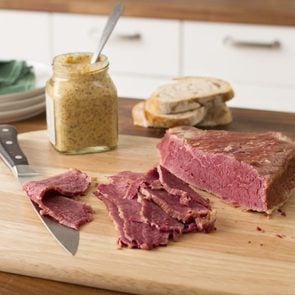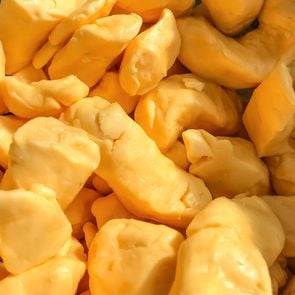Here’s Why Only Some Pickles Have Ridges
Kosher dill. Bread-and-butter. Mini gherkins. Give me all the pickles. And as much as I enjoy a spear on the side of my plate, I love the zing of a pickle slice on a sandwich or burger. But have you ever noticed that some of those pickle slices are flat, while some have ridges? Take note the next time you’re at a deli or even at McDonald’s, where most of the pickles are flat … with the exception of one fancy chicken sandwich that’s a nationwide favorite. It makes me wonder if pickle choices aren’t as arbitrary as they seem—and if those crinkle-cut pickles are actually superior to all other pickles.
Clearly, these questions are important. (Come on, admit it: You’re curious too.) That’s why I reached out to a food historian and a couple of genuine pickle experts to get to the bottom of why only some pickles have ridges. Read on for the dilly-o.
Get Reader’s Digest’s Read Up newsletter for more food news, humor, cleaning, travel, tech and fun facts all week long.
When were pickles invented?
No one knows exactly when pickles were invented, but they go back to classical civilization, according to Ken Albala, PhD, an American food historian and a professor of history at University of the Pacific. “In the earliest books about food in China, about 2,000 or 3,000 years ago, you get directions and descriptions of pickled food and preserved things,” he says.
Because pickling is one of the oldest methods of preserving food, almost every culture around the world has its own pickles or preserved vegetables. In the United States, the arrival of Jewish immigrants from Eastern Europe who settled in New York City in the 1800s boosted the pickle’s popularity, according to Pickles: A Global History by Jan Davison. Pickles were served alongside sandwiches, but over time, some delis began putting thin slices of pickles on the sandwiches themselves—the pop of acid cut through the fat of rich meats like pastrami and corned beef. But pickles on sandwiches really took off with the rise of fast-food burger joints, like McDonald’s, in the 1940s and 1950s.
Why do some pickles have ridges?
Ridged pickle slices gained traction in the 20th century when mass-produced crinkle-cut foods, such as chips and fries, became common. Whether flat or crinkle-cut, pickles contribute tang and flavor to sandwiches. And sure, those ridges make them look prettier, but they’re not just for show. So what else do the ridges bring to the pickle party?
They’re crunchier
“When the ridges are created, they help maintain the crunch and overall strength of the pickles,” says Ryan Lucas, aka The Pickled Guy, a pickle enthusiast and social media influencer. “Since sweeter pickles tend to get softer faster than dill pickles due to the sugar, they are usually crinkle cut to keep them crunchy longer. Nobody likes soggy pickles!” Indeed.
They have more surface area
“When they use one of those little ridge cutters to prick the surface, it exposes more of the surface area,” says Albala. “The salt gets in quicker,” and that means more brine penetration, leading to a stronger pickle flavor. This is why the flavor of crinkle-cut pickles is often more intense than that of smooth-cut slices.
Ridges hold onto sauce better
“The brine or spices may more readily adhere or stick to a crinkle-cut style because of the texture as opposed to a flat surface cut,” says Bob McClure, co-founder and co-owner of McClure’s Pickles. Plus, the ridges will help the condiments, like mayo and mustard, hang on. Think of pasta shapes with lines holding on to sauces better and how much better ridged potato chips work with creamy onion dip.
They help the sandwich hold its shape
“The ridges prevent the pickles from sliding out of the sandwich. If you cut it with a flat knife, when you put pressure down, it could fly off the hamburger or [sandwich],” says Albala. “The crinkle will actually give it some grab.” And that helps it maintain the integrity of the sandwich, so it’s not falling apart as you attempt to eat it.
They add more texture
On a fast-food sandwich, the bun, burger and cheese tend to be soft. Pickle slices add texture—and pickles with ridges add even more texture than flat slices do.
Are crinkle-cut pickles better than flat pickles?

That’s a matter of preference. Crinkle-cut pickles provide extra crunch and more intense flavor; flat slices offer a smoother bite and are often easier to layer evenly on a sandwich. It depends on the type of sandwich and the person eating it.
“This is just my personal preference, but chicken sandwiches need to have the crinkle cut for that crunch factor,” says Lucas. “Hamburgers can have the flatter pickles because all of the other condiments, like the lettuce and onions, help with that. Subs could get the flatter ones—usually thin-sliced just for the flavor.”
Why don’t all pickles have ridges?
There are several reasons that not all pickles on sandwiches have ridges and why flat slices might be the choice of a particular restaurant or sandwich maker. One of the main factors, as you may have guessed, is cost. Some brands market crinkle-cut pickles as a premium option due to their enhanced crunch, leading to slightly higher pricing. That said, though crinkle-cut pickles can be a little more expensive to produce than flat-sliced pickles (because special cutting blades are required and more waste is generated), the difference is nominal, according to McClure.
Beyond straight-up food facts, personal preference also has a lot to do with it. As a pretty good home cook with a food-focused Instagram account, I prefer to use flat pickle slices on turkey and other sandwiches. I find they’re easier to layer evenly—so I get the perfect amount of pickle in every bite.
And last but not least, there’s the nostalgia factor. Since their very beginnings, McDonald’s burgers, for example, have featured thinly sliced flat pickles, so we’ve come to expect that familiarity.
Which fast-food sandwiches have pickles with ridges?
If you’re in the mood for the extra flavor and extra crunch that crinkle-cut pickles provide, here are some picklicious options:
- Burger King: Hamburger, Cheeseburger, Whopper, Whopper Jr.
- Chick-fil-A: Chicken Sandwich, Spicy Chicken Sandwich
- Dave’s Hot Chicken: Slider, Cauli Slider
- Five Guys: Hamburger, Cheeseburger
- Jersey Mike’s: The pickle chips are crinkle-cut at this build-your-own-sandwich chain.
- McDonald’s: McCrispy, Spicy McCrispy
- Subway: The pickle chips are crinkle-cut at this build-your-own-sandwich chain.
- Wendy’s: Classic Chicken Sandwich, Crispy Panko Fish Sandwich, Hamburger
Pickles bring the crunch, the tang and that extra pop to your sandwich. So the next time you take a bite and encounter those ridges, you’ll know why they’re there.
About the experts
|
Why trust us
At Reader’s Digest, we’re committed to producing high-quality content by writers with expertise and experience in their field in consultation with relevant, qualified experts. We rely on reputable primary sources, including government and professional organizations and academic institutions as well as our writers’ personal experiences where appropriate. We verify all facts and data, back them with credible sourcing and revisit them over time to ensure they remain accurate and up to date. Read more about our team, our contributors and our editorial policies.
Sources:
- Ken Albala, PhD, professor of history at University of the Pacific; phone interview, March 11, 2025
- Ryan Lucas, aka The Pickled Guy on TikTok, YouTube and more; email interview, March 12, 2025
- Bob McClure, co-founder and co-owner of McClure’s Pickles; email interview, March 12, 2025
- Pickles: A Global History by Jan Davison
The post Here’s Why Only Some Pickles Have Ridges appeared first on Reader's Digest.
from Reader's Digest https://ift.tt/RMyZCIh



Comments
Post a Comment